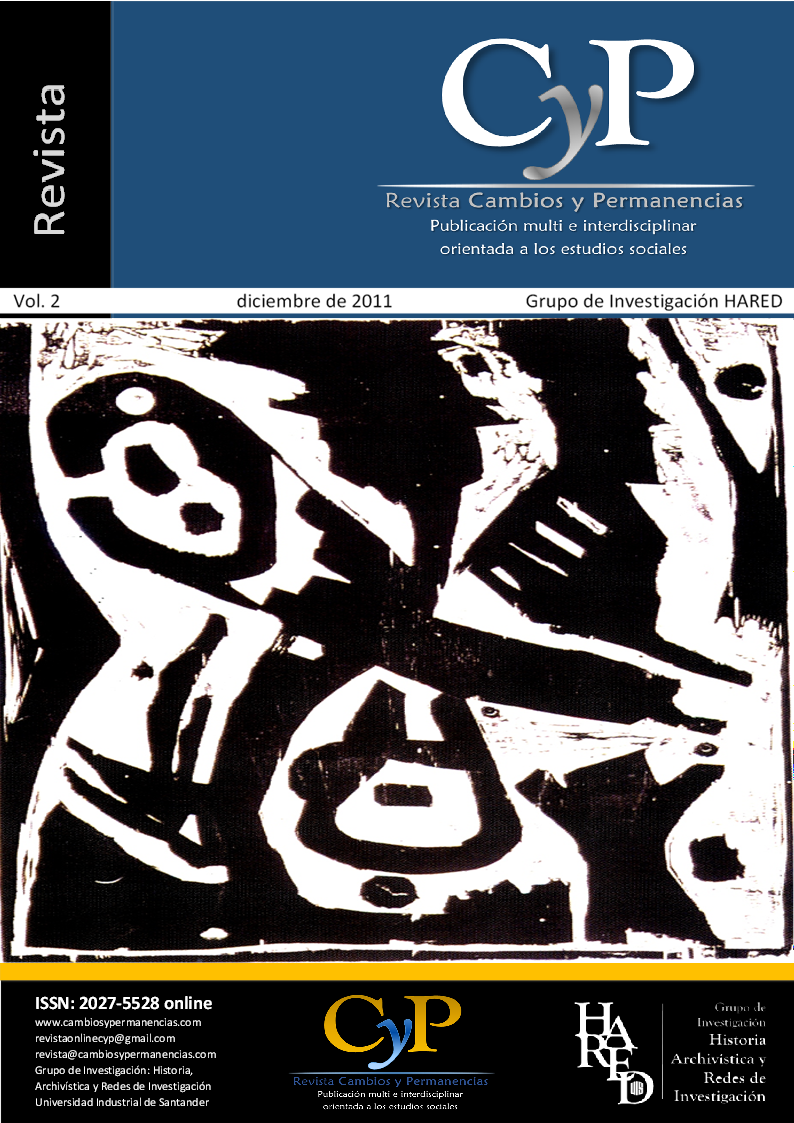Artículos
BEYOND SPATIAL METAPHORS CONCEPTUAL SCAFFOLDING BETWEEN GEOGRAPHY AND SOCIAL MOVEMENTS
Keywords
- Space,
- territory,
- spatial metaphors,
- social movements,
- socio-territorial
How to Cite
Ospina Florido, B. (2011). BEYOND SPATIAL METAPHORS CONCEPTUAL SCAFFOLDING BETWEEN GEOGRAPHY AND SOCIAL MOVEMENTS. Cambios Y Permanencias, (2), 163–186. Retrieved from https://revistas.uis.edu.co/index.php/revistacyp/article/view/7542
Abstract
In recent years, space and territory have become frequently used categories in the world of social science, however, its use has fallen into a kind of manipulation that, in a metaphorical appearance, deprives them of their potential to explain and analytical. In this regard, the following paper seeks to introduce conceptual elements to overcome the mere enunciation of space and territory. In particular, we want to point out how space and the multiple relationships that constitute it, open knowledge options to explain society and its movement.
Downloads
Download data is not yet available.
References
Agnew, J. (1994). Representing space. En J. Duncan y D. Ley. (Eds.) Place, cultura, representation (pp. 251-271). USA y Canada: Routledge.
Benjamin, W. (1999). Sobre el Concepto de la Historia. En Ensayos escogidos. México: Coyoacán.
Fernandes M., B. (2000). Movimiento social como categoría geográfica. Terra Livre, (15), 59-85.
Fernandes M., B. (2005). Movimentos socioterritoriais e movimentos socioespaciais. Observatorio Social de América Latina (Vol. 16), 273-284.
Fernandes M., B. (2008). Movimentos socioterritoriais no campo brasileiro: contribuição para leitura geográfica dos movimentos camponeses. En M. P. Oliveira; M. C. N. Coelho y A. de M. Corrêa. O Brasil, a América Latina e o mundo: espacialidades contemporáneas, (2), 385-404.
Gandler, S. (2003). ¿Por qué el ángel de la historia mira hacia atrás? Acerca de las tesis sobre el concepto de historia de Walter Benjamín. Utopía y praxis latinoamericana, 8(20), 7-39.
Giddens, A. (1984). La constitución de la sociedad. Bases para la teoría de la estructuración. España: Amorrortu.
Gonçalves P., W. (2001). Geo-grafias Movimientos sociales, nuevas territorialidades y sustentabilidad. México: Siglo XXI.
Habermas, J. (2008). El discurso filosófico de la modernidad. Buenos Aires: Katz.
Harvey, D. (1996). Justicia, naturaleza y la geografía de la diferencia, Cambridge: Blackwell Publishers.
Lefebvre, H. (1976). Reflexión y política del espacio. Antipode 8(2), 30-37.
Lefebvre, H. (1994). La producción del espacio (2ª ed.). Oxford,
Merrifield, A. (1993). Place and space: a lefebvrian reconciliation. Transactions of the Institute of British Geographers, 18(4), 516-531.
Oslender, U. (2008). Comunidades negras y espacio en el pacífico colombiano. Hacia un giro geográfico en el estudio de los movimientos sociales. Bogotá: ICAHN.
Ospina Byron, S. Á.; Cardenas F.; Heredia, D. y Castro, S. (2010). Crímenes de Estado y configuración territorial en la región de Sumapaz y Tequendama. Bogotá: Proyecto Colombia Nunca Más.
Sharp, W. (2000). En-tanglements of power: geographies of domination/resistance. Londres.
Benjamin, W. (1999). Sobre el Concepto de la Historia. En Ensayos escogidos. México: Coyoacán.
Fernandes M., B. (2000). Movimiento social como categoría geográfica. Terra Livre, (15), 59-85.
Fernandes M., B. (2005). Movimentos socioterritoriais e movimentos socioespaciais. Observatorio Social de América Latina (Vol. 16), 273-284.
Fernandes M., B. (2008). Movimentos socioterritoriais no campo brasileiro: contribuição para leitura geográfica dos movimentos camponeses. En M. P. Oliveira; M. C. N. Coelho y A. de M. Corrêa. O Brasil, a América Latina e o mundo: espacialidades contemporáneas, (2), 385-404.
Gandler, S. (2003). ¿Por qué el ángel de la historia mira hacia atrás? Acerca de las tesis sobre el concepto de historia de Walter Benjamín. Utopía y praxis latinoamericana, 8(20), 7-39.
Giddens, A. (1984). La constitución de la sociedad. Bases para la teoría de la estructuración. España: Amorrortu.
Gonçalves P., W. (2001). Geo-grafias Movimientos sociales, nuevas territorialidades y sustentabilidad. México: Siglo XXI.
Habermas, J. (2008). El discurso filosófico de la modernidad. Buenos Aires: Katz.
Harvey, D. (1996). Justicia, naturaleza y la geografía de la diferencia, Cambridge: Blackwell Publishers.
Lefebvre, H. (1976). Reflexión y política del espacio. Antipode 8(2), 30-37.
Lefebvre, H. (1994). La producción del espacio (2ª ed.). Oxford,
Merrifield, A. (1993). Place and space: a lefebvrian reconciliation. Transactions of the Institute of British Geographers, 18(4), 516-531.
Oslender, U. (2008). Comunidades negras y espacio en el pacífico colombiano. Hacia un giro geográfico en el estudio de los movimientos sociales. Bogotá: ICAHN.
Ospina Byron, S. Á.; Cardenas F.; Heredia, D. y Castro, S. (2010). Crímenes de Estado y configuración territorial en la región de Sumapaz y Tequendama. Bogotá: Proyecto Colombia Nunca Más.
Sharp, W. (2000). En-tanglements of power: geographies of domination/resistance. Londres.

